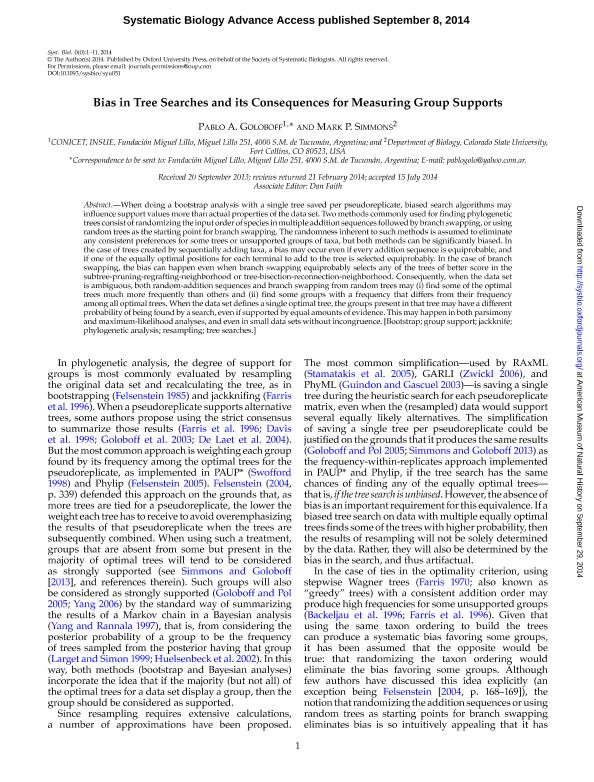Mostrar el registro sencillo del ítem
dc.contributor.author
Goloboff, Pablo Augusto

dc.contributor.author
Simmons, Mark P.
dc.date.available
2016-08-22T14:42:09Z
dc.date.issued
2014-09
dc.identifier.citation
Goloboff, Pablo Augusto; Simmons, Mark P.; Bias in tree searches and its consequences for measuring groups supports; Oxford University Press; Systematic Biology; 63; 6; 9-2014; 851-861
dc.identifier.issn
1063-5157
dc.identifier.uri
http://hdl.handle.net/11336/7264
dc.description.abstract
When doing a bootstrap analysis with a single tree saved per pseudoreplicate, biased search algorithms may influence support values more than actual properties of the data set. Two methods commonly used for finding phylogenetic trees consist of randomizing the input order of species in multiple addition sequences followed by branch swapping, or using random trees as the starting point for branch swapping. The randomness inherent to such methods is assumed to eliminate<br />any consistent preferences for some trees or unsupported groups of taxa, but both methods can be significantly biased. In the case of trees created by sequentially adding taxa, a bias may occur even if every addition sequence is equiprobable, and if one of the equally optimal positions for each terminal to add to the tree is selected equiprobably. In the case of branch swapping, the bias can happen even when branch swapping equiprobably selects any of the trees of better score in the<br />subtree-pruning-regrafting-neighborhood or tree-bisection-reconnection-neighborhood. Consequently, when the data set is ambiguous, both random-addition sequences and branch swapping from random trees may (i) find some of the optimal trees much more frequently than others and (ii) find some groups with a frequency that differs from their frequency among all optimal trees. When the data set defines a single optimal tree, the groups present in that tree may have a different probability of being found by a search, even if supported by equal amounts of evidence. This may happen in both parsimony and maximum-likelihood analyses, and even in small data sets without incongruence.
dc.format
application/pdf
dc.language.iso
eng
dc.publisher
Oxford University Press

dc.rights
info:eu-repo/semantics/openAccess
dc.rights.uri
https://creativecommons.org/licenses/by-nc-sa/2.5/ar/
dc.subject
Phylogeny
dc.subject
Tree.Searches
dc.subject
Supports
dc.subject.classification
Biología

dc.subject.classification
Ciencias Biológicas

dc.subject.classification
CIENCIAS NATURALES Y EXACTAS

dc.title
Bias in tree searches and its consequences for measuring groups supports
dc.type
info:eu-repo/semantics/article
dc.type
info:ar-repo/semantics/artículo
dc.type
info:eu-repo/semantics/publishedVersion
dc.date.updated
2016-08-17T15:40:18Z
dc.journal.volume
63
dc.journal.number
6
dc.journal.pagination
851-861
dc.journal.pais
Reino Unido

dc.journal.ciudad
Oxford
dc.description.fil
Fil: Goloboff, Pablo Augusto. Universidad Nacional de Tucumán. Facultad de Ciencias Naturales e Instituto Miguel Lillo. Instituto Superior de Entomología; Argentina. Consejo Nacional de Investigaciones Científicas y Técnicas. Centro Científico Tecnológico Tucumán; Argentina
dc.description.fil
Fil: Simmons, Mark P.. State University Of Colorado - Fort Collins; Estados Unidos
dc.journal.title
Systematic Biology

dc.relation.alternativeid
info:eu-repo/semantics/altIdentifier/url/http://sysbio.oxfordjournals.org/content/63/6/851.long
dc.relation.alternativeid
info:eu-repo/semantics/altIdentifier/doi/10.1093/sysbio/syu051
dc.relation.alternativeid
info:eu-repo/semantics/altIdentifier/doi/http://dx.doi.org/10.1093/sysbio/syu051
Archivos asociados
